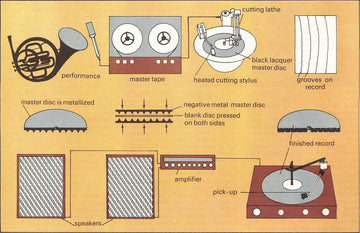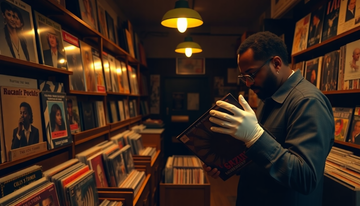How Do Vinyl Records Work? Understanding the Science of Analog Sound
In a world dominated by digital streams and instant playlists, vinyl records continue to spin their magic. These grooved discs, symbols of timeless artistry, have survived decades of innovation—offering a warm, analog sound that digital formats often lack. But have you ever wondered how vinyl records work? From their fascinating history to the science behind the sound, this blog breaks down everything you need to know.
🎵 What Are Vinyl Records? A Brief History
The story of vinyl records begins in 1877 with Thomas Edison’s invention of the phonograph, a device that recorded sound onto a rotating cylinder covered in tin foil.
Key Milestones in Vinyl Evolution:
- 1877 – Edison’s Phonograph: Used cylinders to capture sound vibrations.
- 1887 – Emile Berliner’s Gramophone: Introduced flat discs, making mass production possible.
- 1930 – First Vinyl Long-Playing (LP) Record: RCA Victor launches the 33 1/3 rpm LP, transforming music distribution.
- 1950s–60s – Shellac Decline: Vinyl replaces shellac due to better sound quality and durability.
- 1982 – Rise of CDs: Compact Discs shift the industry toward digital.
- 2008–Present – Vinyl Revival: Sales soar as a new generation rediscovers the joy of analog sound.
From Edison’s early innovations to today’s beautifully crafted LPs, vinyl has not only survived but evolved—driven by music lovers seeking a deeper, more authentic experience.
🔍 How Do Vinyl Records Work?
Vinyl records store sound as tiny physical grooves carved into the surface of the disc. These grooves are analog representations of audio waveforms.
🌀 The Grooves and Stylus
When a record spins on a turntable:
- A stylus (needle) rides along the grooves.
- The stylus vibrates according to the groove’s contours.
- These vibrations are carried to a cartridge, which converts them into an electrical signal.
- That signal is amplified and sent to speakers, producing the rich sound we hear.
This entire process is mechanical and analog, preserving the exact movement of sound waves—unlike digital formats that compress and sample data.
🔬 The Science Behind the Sound
Each groove on a vinyl record is a physical map of the original sound wave. The hills and valleys etched into the vinyl represent frequency and amplitude.
Why does vinyl sound “warmer”?
- It captures continuous analog waveforms, not just digital snapshots.
- It often includes the natural harmonics and imperfections of the original recording.
- It’s full of subtle textures—pops, crackles, and dynamic depth—that digital formats flatten.
This is why audiophiles cherish vinyl: it feels more alive and emotionally resonant.
🎛️ How Are Vinyl Records Made?
The process of making vinyl records blends science, art, and precision craftsmanship.
Steps in Vinyl Record Production:
- Mastering – A mastering engineer creates a lacquer master disc from the original recording.
- Electroplating – The lacquer is used to make a metal stamper.
- Pressing – Heated vinyl pellets are pressed between stampers to create grooves.
- Cooling & Trimming – The record is cooled, cut, and inspected for quality.
- Packaging – The vinyl is sleeved and jacketed for shipping.
This end-to-end analog process ensures that what you hear is as close as possible to what the artist intended.
🎚️ Vinyl Playback: From Grooves to Music
A turntable might look simple, but it’s a symphony of components working together to turn grooves into sound.
Key Turntable Parts:
- Platter: Spins the record at a consistent speed (33 1/3 or 45 rpm).
- Tonearm: Holds the stylus and allows it to track the groove.
- Stylus (Needle): Vibrates with the groove’s movement.
- Cartridge: Converts vibrations into electrical signals.
- Preamp & Amplifier: Boosts the signal for playback on speakers.
Higher-quality components improve accuracy, depth, and clarity of the final sound.
✨ The Vinyl Experience
Listening to vinyl is not just about music—it's a ritual.
From unboxing the sleeve to placing the needle and hearing that first crackle, the vinyl experience is tactile, immersive, and nostalgic. You don’t just play a record—you engage with it. You feel it.
In an age of digital convenience, vinyl invites us to slow down and connect with music in a more intimate, meaningful way.
📌 Frequently Asked Questions
Q: How do vinyl records produce sound?
A: The stylus follows grooves on the disc, converting their physical patterns into electrical signals, which are then amplified into sound.
Q: Why do vinyl records sound different from digital?
A: Vinyl captures full analog waveforms and subtle imperfections, offering warmth and depth lost in compressed digital files.
Q: Are vinyl records fully analog?
A: Yes. From recording to playback, vinyl is a fully analog format—no digital encoding involved.
🎧 Final Thoughts: Why Vinyl Still Spins Hearts
Vinyl records offer something few modern formats can: a complete sensory experience. They connect us to the history of music, to the artistry of sound, and to the joy of listening with intention.
Whether you’re a seasoned collector or a curious newcomer, exploring vinyl is a journey worth taking. And at Vinyl.ae, we’re proud to help you take that next step.






